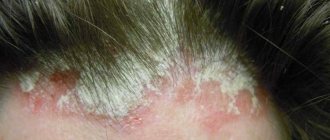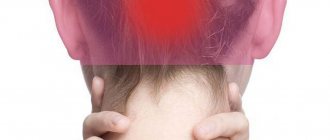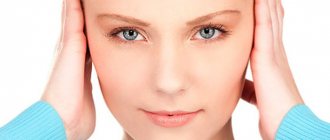Signs of migraine
Migraine is characterized by the onset after the appearance of precursors - weakness, weakness, unpleasant odors or other sensations. This is the so-called “aura”. If the aura is followed by pain on the right side of the head, the doctor will first consider a diagnosis of migraine.
Migraine pain is characterized by paroxysmal, burning sensations: the patient experiences pressure on the right eye, photophobia occurs, and nausea appears. The pain is sharp, intensifies, and is localized on the right side of the head. Unfortunately, it is still unclear why migraines occur; it is only clear that the problem is neurological in nature. Usually doctors look at the whole picture and strive to eliminate possible causes: psycho-emotional stress, overexertion, trauma.
There is a throbbing pain in the head: when should you see a doctor?
There are situations in which a visit to the doctor is inevitable, and the sooner the better for a person to dull the pain at an early stage. So, you should visit a doctor if:
- The throbbing pain does not go away for several hours.
- Intense pain does not stop for several days and brings significant discomfort
- Pain in the back of the head begins in the early morning.
- If the pressure increases during pulsation, you must definitely call an ambulance to avoid a hypertensive crisis.
Sinusitis and other ENT inflammations
Chronic and acute ENT infections often lead to severe headaches. For example, the cause of pain in the head on the right can be sinusitis - inflammation of the mucous membranes of the paranasal sinuses. In addition to direct pain, symptoms of sinusitis include nasal discharge, fever; it usually appears from an untreated runny nose and develops into an unpleasant chronic disease. If your headache is combined with nasal discharge, contact an infectious disease specialist or therapist at your place of registration - he will tell you how to cope with the disease.
General description of the condition
The official name of the pathology is “cranialgia”. There is no need for provoking reasons for the appearance of paresis; pain occurs on its own unexpectedly. The anomaly can be characterized by the following features:
- a sudden painful impulse lasting from a few seconds to many hours (sometimes persistent);
- high intensity of pain, further intensifying when moving the eyeballs;
- it is impossible to touch the affected area, analgesics are also powerless;
- The temporal and occipital region suffers most often;
- there is a possibility of fever or vomiting;
- irradiation to the shoulder girdle, neck, shoulder blades;
- twitching sensations in the ears when hearing sounds;
- touching the face, smiling, coughing lead to new lumbago, “bell blows” inside the skull;
- arms and legs become numb, muscles are pulled, gait becomes swaying;
- gradually developing apathy to what is happening around, all thoughts are occupied with pain.
In the chronic course of the pathology, when it manifests itself quite often, intellectual and psychological changes occur, since pain displaces all other sensations and emotions. A person is busy only with himself, constantly expects an attack, becomes irritable, loses interest and the ability to remember basic data (for example, the security code of a plastic card or his telephone number).
Problems in the temporomandibular joint
The lower jaw is connected to the skull by a cartilaginous disc, which can become inflamed or “wear out” because it is a moving part. A problem with the temporomandibular joint is quite easy to recognize: in addition to acute pain localized on the right, there are sensations of “shooting” in the eye and ear, the face may become asymmetrical, a burning sensation in the mouth, dryness or increased salivation may appear. If you suspect this pathology, you should contact your dentist - he will prescribe a diet, medications and, if necessary, refer you to a surgeon. If the joint is completely destroyed, it is replaced with an implant.
How to help yourself?
It is important to improve your sleep. Maybe drink motherwort, valerian infusion
It is worth giving up strong caffeine-containing drinks and replacing them with herbal tea with the addition of mint, chamomile, and thyme.
Acupressure massage relieves attacks of pain by massaging the head with your fingertips, starting from the place with more severe pain, gradually moving to the forehead, temples, eyes, and head. If there has been a head injury or there is a suspicion of the development of a tumor, then massage is contraindicated. These are serious problems. Treatment is carried out only by a doctor.
With severe and prolonged pain, dizziness, nausea, vomiting, cerebral hemorrhage, a pre-stroke condition, is possible. In emergency cases, surgery and the actions of a surgeon cannot be avoided. You won't be able to help yourself anymore. You need to call an ambulance or go to the emergency room urgently.
Neuralgia pain
Neuralgia pain is provoked by cold water, air, and sudden movements. For example, when washing with cold water, a sharp pain in the head on the right may occur, which undoubtedly indicates neuralgia.
Pressing, burning, bursting and dull pain in the head on the right appears with the same migraine. Often it can spread to other areas of the head and spread to the entire skull. There are other, more rare causes of headaches on the right.
In order to help a patient with such pain, it is undoubtedly necessary to establish an accurate diagnosis. Migraine can be successfully treated with both medications and osteopathic craniosacral techniques. Neuralgia is quite difficult to treat; medications, as a rule, do not help. But, fortunately, many types of neuralgia can be corrected using osteopathic techniques.
So, if pain in the head on the right is caused by a pinched nerve in the exit channel, then alignment and balancing of the skull bones can completely relieve the patient of this problem. In our center, Dr. Malyutin A.G. can see you with this problem. and others. Make an appointment!
Treatment
Conservative therapy
The treatment plan is drawn up taking into account the nature of the disease. The following medications and non-drug methods are used:
- Migraine.
To eliminate paroxysms, non-narcotic analgesics are prescribed. For persistent attacks, blockades are performed. For intense excruciating pain and migraine status, triptans are used in tablets, rectal suppositories, and solutions for parenteral administration. The last two options allow you to solve the problem of taking the drug for persistent vomiting. - Paroxysmal hemicrania.
NSAIDs, glucocorticosteroids, and calcium channel blockers are effective. Depending on the severity of the pathology, medications are taken in short courses or continuously. - Cluster headache.
Painful attacks are eliminated with the help of triptans and applications of local anesthetics to the nasal mucosa. The effectiveness of inhalation of 100% oxygen is noted. Preventive measures in the interictal period are carried out using calcium channel blockers, hormonal, and antiepileptic medications. - Hypnic headache.
The basis of treatment is hypnotics, lithium preparations, and atypical benzodiazepines. Some researchers have reported the effectiveness of steroids and NSAIDs. Before going to bed, patients are advised to take caffeine-containing and melatonin-containing medications. - Vertebrobasilar insufficiency.
Antiplatelet agents, anticoagulants, neuroprotectors, antihypertensive, vascular drugs, exercise therapy, massage, manual therapy, hyperbaric oxygenation, magnetic therapy, laser therapy are recommended. - Tumors.
To reduce the severity of symptoms, non-narcotic and narcotic analgesics, antiemetics, glucocorticoids, and psychotropic drugs are used. Radiation and chemotherapy are carried out as part of palliative therapy or are part of complex treatment in the pre- and postoperative period. - Spinal pathologies.
Pain is eliminated with the help of oral and parenteral forms of NSAIDs, muscle relaxants, and local administration of glucocorticosteroids. They use B vitamins, neurometabolites, phonophoresis, UHF, electrophoresis, and magnetic therapy. - ENT diseases.
Treatment regimens include antibacterial, vasoconstrictor, antihistamines, physiotherapy, paracentesis of the tympanic membrane, and puncture of the paranasal sinuses.
Surgery
Treatment of primary cephalgia is only conservative. For other pathologies, the following may be indicated:
- Vertebrobasilar insufficiency
: reconstructive surgery to restore blood flow. - Brain neoplasia
: removal of cerebral tumors using traditional and minimally invasive surgical techniques. - Spinal diseases
: low-traumatic (endoscopic microdiscectomy, puncture laser vaporization) and traditional (discectomy) interventions for hernias, sometimes in combination with fixation operations. - Pathologies of ENT organs
: sanitizing surgery, mastoidotomy, frontotomy, maxillary sinusotomy, micromaxillary sinusotomy.
Why does my head hurt?
To date, more than three dozen probable causes of cephalgia have been identified. The most common ones are:
- traumatic brain injuries;
- arterial hypertension;
- inflammatory processes in the brain, paranasal sinuses, ears;
- diseases of the eyes, teeth;
- neurological and cerebrovascular disorders;
- neoplasms of various types;
- osteochondrosis of the spinal column in the cervical region;
- viral infections.
If the origin of pain attacks is unknown, the nature, strength and location of the impulses will help to find out.
Anatomical meaning
Through a person’s neck, as if through a “connecting link” between his head and body, various connecting and supplying structures pass:
- blood vessels through which blood flows to the brain;
- muscles and vertebrae (from 1st to 7th), due to which head mobility is ensured;
- the larynx, which is directly involved in the respiratory process;
- The esophagus is an important element of the digestive system.
Naturally, with such multifunctionality, pathologies with various causes and symptoms can develop in the neck area.
Medical therapy for headaches radiating to the eye
In modern pharmacology there is a fairly large selection of a wide variety of painkillers. But it’s still not worth buying them yourself, without a doctor’s recommendations. After all, some of them can be addictive or have a negative impact on other organs and systems.








